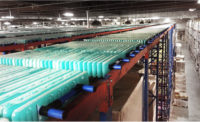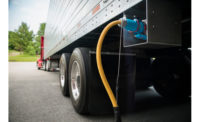A large international grocery chain invited Viking Cold Solutions, Inc., Houston, Texas, to conduct a measurement and verification study of its thermal energy storage (TES) technology. The purpose of the study was to determine the effectiveness of TES in a typical grocery storage freezer environment. Viking Cold's patented TES solution was installed in the 320-square-foot main grocery walk-in freezer at the Fremont, Calif., store. The freezer was equipped with a Hussmann Protocol rack refrigeration system, Emerson E2 controls and Parasense monitoring.
Experiment 0: Baseline
To establish the baseline performance of the freezer, all related equipment ran under normal operating conditions without Viking Cold Systems’ intervention for two weeks. During this period, the Viking Cold system monitored energy consumption, temperatures and refrigeration equipment status. The daily energy usage values were recorded and plotted against the daily average outside air temperature for the baseline period. CLICK HERE to access the charts.
A best-fit linear equation normalized the daily energy usage with outside ambient temperatures. This weather normalization formula calculates energy savings during the tests by subtracting actual measured energy consumption from calculated baseline consumption.
In addition to energy consumption, the system recorded room temperature, product temperature and equipment status throughout the duration of the test to quantify and analyze other system behaviors. CLICK HERE to see the baseline equipment performance and freezer temperature profile.
Experiment results
Experiment 1: Energy reduction. The goal of this experiment was to reduce the net daily energy consumption while maintaining temperature stability. The equipment control algorithms were configured to run the refrigeration equipment extensively at night to fully charge (freeze) the TES cells while ambient temperatures are lower, yielding maximum condensing efficiency. As ambient temperatures increase during the day and heat rejection of the condenser is less efficient, the control algorithms allow the TES to take over the duty of maintaining temperatures inside the freezer
The energy reduction experiment was conducted over 10 days. The results of the test were favorable, reducing net consumption by 18% compared to the baseline. Similar consumption results were achieved by running intelligent controls only, however there was a significant improvement in temperature stability with TES. Further experiments showed challenges unique to this typical grocery freezer application.
Experiment 2: Load shift. The goal of this experiment was to minimize energy consumption during peak periods and/or minimize peak demand by running refrigeration equipment during utility off-peak periods. The benefit of this operating scenario is a reduction of energy costs from time-of-day kW demand charges associated with peak periods. For this test, the designated peak period was 8:30 a.m. to 9:30 p.m.
The load shift experiment was conducted over 10 days and significantly reduced peak consumption for long periods of time. Power consumption dropped from 6 kW to less than 1 kW, an 85% reduction. The TES could not maintain the temperature within control limits for the entire length of the peak period. On average, the TES eliminated a total of 6.5 hours of energy consumption, with the longest single period of load shift lasting for 2-plus hours before the upper temperature control limit was reached and refrigeration was initiated. CLICK HERE to review the temperature, equipment status and energy consumption of a sample day during the load shift test.
Experiment 3: Solar shift. In this test, solar shift refers to leveraging photovoltaic (PV) generation by running refrigeration during PV generation times (7:00 a.m. to 7:00 p.m.) and reducing runtime when there is no PV generation. The goal of this experiment was to minimize on-grid energy consumption between 7:00 p.m. and 7:00 a.m., with particular focus between 7:00 p.m. and 12:00 a.m. (duck curve avoidance). At this test site, there is no PV generation, but the test was carried out as if peak PV generation was available during the peak sunlight hours of 7:00 a.m. to 7:00 p.m.
The solar shift experiment was conducted for 20 days and successfully demonstrated how TES can significantly shift demand to PV generation hours. CLICK HERE to see a sample day from the experiment, which demonstrates how the TES system was able to turn off refrigeration for a total of 6.5 of the 12 non-solar-generation hours (7:00 p.m. to 7:00 a.m.) and maintain temperature control limits. During the first 5-plus hours of night (duck curve period), the TES reduced power consumption from 7 kW to 2 kW (70% reduction) and maintained temperatures within control limits.
Analysis: Temperature stability
Throughout the duration of these experiments, the TES measured and recorded product temperatures inside the freezer to determine the benefits on temperature stability. Two dependent variables were analyzed to quantify temperature stability—standard deviation of temperature amplitude and rate of temperature rise.
Rate of rise is a measure of how quickly the product temperature increased after the refrigeration equipment was shut off, and temperature amplitude is a measure of the standard deviation of the temperature range throughout the day.
The temperature stability analysis demonstrates the benefits of TES. Both dependent variable measures of temperature stability showed improvement with TES. The average standard deviation reduction across the three experiments was 23%, and the average rate of temperature rise was reduced by 38%. CLICK HERE to understand the quantified temperature stability benefits.
Commentary
The original goal of this M&V study was to determine the effectiveness of TES in a typical grocery store freezer environment. However, more was discovered about the refrigeration and energy challenges facing grocery operators.
For instance, this study revealed that integrating TES into a grocery freezer has significant energy and cost benefits across a variety of energy management applications.
In the first experiment where energy consumption reduction was the goal, it was discovered that small grocery walk-in freezers experience heat infiltration loads that are very severe during operating hours. The large door opening size relative to the internal volume of the freezer results in very quick air changeover. This condition is made even more severe when the freezer is in the back room of the store, very close to an open dock door, or when the strip curtains are tied back to facilitate hassle-free egress by the store associates performing their daily duties. Even with these challenging conditions, TES provided more stable temperatures while protecting the food product and reducing net energy consumption by 18%.
In the second experiment where the goal was extended load shed to avoid peak utility rates, it was learned that prolonged periods of near-total electrical load shed were achievable while keeping the food product protected with temperature stability provided by the TES. For grocery operators facing steep energy penalties for demand peaks, utilizing the benefits of TES during known daily high-demand periods (such as prepared meal cooking hours) can significantly reduce their peak demand charges for the month. For others who already have a micro-grid management system or participate in ADR programs, the freezer load can now be shed for hours at a time for peak shaving and demand sequencing.
In the third experiment where PV generation was simulated to minimize on-grid consumption at night, the study revealed that the entire duck curve period after sunset can be avoided by utilizing the TES stored energy while keeping the food product protected and the temperature stable. Furthermore, the daily operating requirements of a grocery freezer are best aligned with the evening shed since the door openings are at a minimum and the TES can preserve temperature stability inside the freezer for longer periods of time.
Conclusion
TES achieved 38% greater temperature stability inside the grocery freezer under normal operating conditions. This additional stability enabled the refrigeration equipment to be turned off for extended periods of time, reducing the electricity load by 70% or more during those periods.


